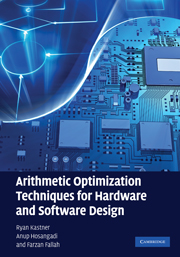2 - Use of polynomial expressions and linear systems
Published online by Cambridge University Press: 03 May 2010
Summary
Chapter overview
Polynomial expressions and linear systems are found in a wide range of applications: perhaps most fundamentally, Taylor's theorem states that any differentiable function can be approximated by a polynomial. Polynomial approximations are used extensively in computer graphics to model geometric objects. Many of the fundamental digital signal processing transformations are modeled as linear systems, including FIR filters, DCT and H.264 video compression. Cryptographic systems, in particular, those that perform exponentiation during public key encryption, are amenable to modeling using polynomial expressions. Finally, address calculation during data intensive applications requires a number of add and multiply operations that grows larger as the size and dimension of the array increases. This chapter describes these and other applications that require arithmetic computation. We show that polynomial expressions and linear systems are found in a variety of applications that are driving the embedded systems and high-performance computing markets.
Approximation algorithms
Polynomial functions can be used to approximate any differentiable function. Given a set of points, the unisolvence theorem states that there always exists a unique polynomial, which precisely models these points. This is extremely useful for computing complex functions such as logarithm and trigonometric functions and forms the basis for algorithms in numerical quadrature and numerical ordinary differential equations. More precisely, the unisolvence theorem states that, given a set of n + 1 unique data points, a unique polynomial with degree n or less exists.
- Type
- Chapter
- Information
- Publisher: Cambridge University PressPrint publication year: 2010

